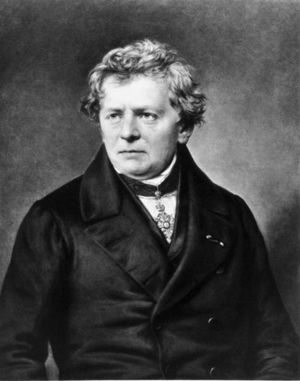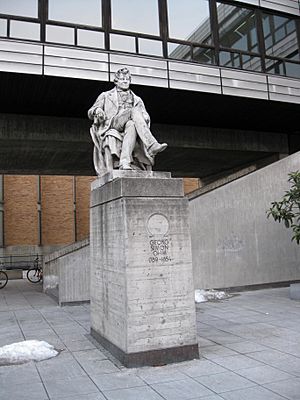Georg Ohm facts for kids
Quick facts for kids
Georg Simon Ohm
|
|
|---|---|
 |
|
| Born | 16 March 1789 |
| Died | 6 July 1854 (aged 65) |
| Nationality | German |
| Alma mater | University of Erlangen |
| Known for | Ohm's law Ohm's phase law Ohm's acoustic law |
| Awards | Copley Medal (1841) |
| Scientific career | |
| Fields | Physics (studies of electricity) |
| Institutions | University of Munich |
| Doctoral advisor | Karl Christian von Langsdorf |
Georg Simon Ohm (born March 16, 1789 – died July 6, 1854) was a German physicist and mathematician. He was a school teacher who loved to experiment.
Ohm started his research using a new invention: the electrochemical cell. This device was created by the Italian scientist Alessandro Volta. Using tools he made himself, Ohm discovered something important about electricity. He found a direct link between the voltage (electrical push) and the electric current (flow of electricity). This discovery is now known as Ohm's law. The unit of electrical resistance, called the ohm, is named after him.
Contents
Biography
Ohm's Early Life and Family
Georg Simon Ohm grew up in a Protestant family in Erlangen, which was part of the Holy Roman Empire at the time. His father, Johann Wolfgang Ohm, was a locksmith. His mother, Maria Elizabeth Beck, was a tailor's daughter.
Even though his parents didn't have much formal schooling, Ohm's father was very smart. He taught himself a lot and gave his sons an excellent education at home. Georg was one of three children who lived to adulthood. His younger brother, Martin, also became a famous mathematician. Their mother passed away when Georg was ten years old.
Learning and University Years
From a young age, Georg and Martin learned a lot from their father. He taught them about mathematics, physics, chemistry, and philosophy. Georg went to Erlangen Gymnasium from age eleven to fifteen. However, he felt that the science training there wasn't as good as what his father taught him.
Georg's father worried that his son might not use his talents fully. So, he sent Georg to Switzerland. In 1806, Ohm started working as a mathematics teacher in a school there.
Later, a professor named Karl Christian von Langsdorf moved from the University of Erlangen. Ohm wanted to continue his math studies with him. Langsdorf advised Ohm to study math on his own, reading books by famous mathematicians like Leonhard Euler. Ohm followed this advice. He left his teaching job and became a private tutor for two years. During this time, he studied mathematics by himself. In 1811, he returned to the University of Erlangen.
Ohm's Teaching Career
Ohm's hard work paid off. He earned his doctorate degree from the University of Erlangen in October 1811. He then became a lecturer in mathematics there. But he left after a short time because the pay was not enough to live on.
The government offered him a job teaching math and physics at a school in Bamberg. Ohm took the job in 1813, even though he wasn't very happy there. To show his skills, he started writing a textbook on geometry.

After this school closed, Ohm sent his textbook to King Wilhelm III of Prussia. The King was impressed and offered Ohm a position at a good school in Cologne in 1817. This school had a strong science program. Ohm taught physics and math there. The physics lab was well-equipped, which allowed Ohm to start his important experiments. As a locksmith's son, he had practical skills with tools.
In 1827, Ohm published his famous book, Die galvanische Kette, mathematisch bearbeitet. This means The Galvanic Circuit Investigated Mathematically. Sadly, his colleagues at the school didn't appreciate his work, and Ohm resigned. He then got a job at the Polytechnic School of Nuremberg in 1833. Later, in 1852, he became a professor of experimental physics at the University of Munich.
Ohm passed away in Munich in 1854. He is buried in the Alter Südfriedhof. His family letters show his deep faith, often signing off with "Commended to God."
Discovery of Ohm's Law
What is Ohm's Law?
Ohm's law was first explained in his famous 1827 book, Die galvanische Kette, mathematisch bearbeitet. In this book, he presented his full theory of electricity. He stated that the electrical push (voltage) across any part of an electrical circuit is equal to the strength of the electric current multiplied by the electrical resistance of that part.
This means if you have more voltage, you get more current, as long as the resistance stays the same. If you have more resistance, you get less current for the same voltage.
How Ohm's Law Changed Science
Ohm's book began with the math needed to understand his ideas. His work greatly influenced how we understand and use electricity today. However, at first, people didn't fully accept his ideas.
Ohm believed that electricity moved between tiny "contiguous particles." This was different from other ideas at the time. His work helped start the field of circuit theory, which became very important later on.
Ohm's Acoustic Law
Understanding Sound with Ohm's Acoustic Law
Georg Ohm also studied sound. His Ohm's acoustic law, sometimes called the acoustic phase law, talks about how we hear music. It says that our ears hear a musical sound as a mix of many pure, simple tones. While this law isn't perfectly true for all sounds, it was an important step in understanding how we hear.
Study and Publications
Ohm's Important Discoveries
Ohm's first paper in 1825 looked at how the strength of an electric force decreased as a wire got longer. In 1826, he described how electricity moves through circuits. He used ideas similar to how heat moves. These papers helped him propose laws that explained the work of other scientists studying electricity.
His most important work was the book published in 1827, Die galvanische Kette mathematisch bearbeitet. This book had a huge impact on the study and uses of electric current. Ohm's name is now a key part of electrical science. We have Ohm's Law and the ohm (symbol Ω), which is the SI unit for electrical resistance.
Even though Ohm's work was very important, it wasn't immediately popular. But eventually, his discoveries were recognized. The Royal Society awarded him the Copley Medal in 1841. He became a foreign member of the Royal Society in 1842 and a full member of the Bavarian Academy of Sciences and Humanities in 1845.
See also
 In Spanish: Georg Simon Ohm para niños
In Spanish: Georg Simon Ohm para niños

